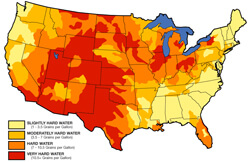Hard pool water has elevated levels of calcium and magnesium, as measured by a Total Hardness test, also known as Calcium Hardness.
For swimming pools, the range of acceptable hardness levels is 200-400 ppm, although many suggest a tighter range of 180-220 ppm for plaster pools and 150-250 ppm for vinyl pools.
Problems with Pool Water Hardness
 In many parts of the country, tap water with hardness levels of 400-800 ppm is not uncommon. High calcium levels can lead to scaling, especially if pH levels are allowed to rise, which produces whitish scale or crystalline deposits, at the water line, inside pipes or all over the pool.
In many parts of the country, tap water with hardness levels of 400-800 ppm is not uncommon. High calcium levels can lead to scaling, especially if pH levels are allowed to rise, which produces whitish scale or crystalline deposits, at the water line, inside pipes or all over the pool.
Excessive water hardness can also come out of solution, precipitating into repeated bouts with cloudy water, or calcium stains as hard minerals mix with dirt and oils.
Controlling Calcium Hardness in Pools
As opposed to removing calcium in pools, many pool owners opt to control the mineral build-up in pools. The primary method of control is to keep well-balanced pH and alkalinity levels. With a proper pH of 7.2-7.4 and Total Alkalinity of 80-100 ppm, high levels of calcium rarely become problematic.
 Secondly, using a sequestering agent like Scale Free or Stain Away, will lock-up minerals (sequester) with a strong chemical bond, that will keep calcium from precipitating out of solution, to form scale or visibly cloud the water.
Secondly, using a sequestering agent like Scale Free or Stain Away, will lock-up minerals (sequester) with a strong chemical bond, that will keep calcium from precipitating out of solution, to form scale or visibly cloud the water.
Avoiding use of calcium based sanitizers, such as Calcium Hypochlorite, is also recommended as a way to reduce calcium build-up. Lithium, Dichloride or non-chlorine shock can be used as alternative pool shocks, that won’t add calcium to the pool.
Reducing Calcium Hardness in Pools
If you’re beyond controlling calcium hardness and actually want to reduce pool hardness levels, there are a few ways to lower calcium levels in pools.
The best method is to drain a portion of the pool and refill with water that has been treated with a home water softening system, or from trucked-in water with a lower calcium content. Captured rain water, which has 0 ppm of calcium hardness, has also been used by some as a means to reduce calcium levels.
 A second method to reduce pool water hardness is to use commercially available calcium hardness reducers, such as Cal Treat by United Chemicals. Cal Treat is a formula of sodium hexa-metaphosphate, which when used correctly, will exchange calcium for sodium, while phosphates promote polymer adhesion to the calcium carbonate, for removal by your pool filter. This method however, increases levels of orthophosphates in the water, which may cause other problems, e.g. algae blooms.
A second method to reduce pool water hardness is to use commercially available calcium hardness reducers, such as Cal Treat by United Chemicals. Cal Treat is a formula of sodium hexa-metaphosphate, which when used correctly, will exchange calcium for sodium, while phosphates promote polymer adhesion to the calcium carbonate, for removal by your pool filter. This method however, increases levels of orthophosphates in the water, which may cause other problems, e.g. algae blooms.
Purposeful precipitation of calcium carbonate by raising pH and Alkalinity, to cloud the pool water is another method. Cloud the pool water on purpose, and then using a flocculate such as aluminum sulfate, to drop suspended material to the floor. This method is risky however, because it is possible that the calcium may decide to deposit as scale and crystals on the pool surface.
Finally, reverse osmosis filtering can remove calcium from pool water. Systems like PuriPool or Calsaway, available in certain hard water areas will visit your pool with truck mounted RO filters, to super-clean your pool water, while reducing calcium, TDS, phosphates, nitrates, cyanuric acid and more.
Hard water affects a large percentage of pool owners around the world, if your pool has very high levels of calcium hardness, you’re not alone! Reduce pool calcium levels below 400 ppm, for best results.
No comments:
Post a Comment